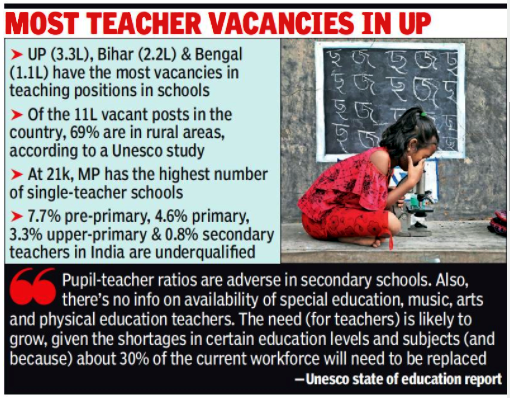Governance
2021 State of the Education Report for India: UNESCO
- 07 Oct 2021
- 4 min read
Why in News
On the Occasion of the World Teachers’ Day (5th October), the United Nations Educational, Scientific and Cultural Organization (UNESCO) launched its 2021 State of the Education Report (SOER) for India: “No Teacher, No Class”.
Key Points
- About:
- The findings are largely based on analysis of Periodic Labour Force Survey (PLFS) and the Unified District Information System for Education (UDISE) data (2018-19).
- It aims to serve as a reference for enhancing the implementation of the National Education Policy (NEP) and towards the realization of the Sustainable Development Goal (SDG) 4 (target 4c on teachers).
- Target 4c: By 2030, substantially increase the supply of qualified teachers, including through international cooperation for teacher training in developing countries, especially least developed countries and small island developing States.
- Findings of the Report:
- Lack of Teachers:
- There are nearly 1.2 lakh single-teacher schools in the country of which an overwhelming 89% are in rural areas.
- The report projects that India needs 11.16 lakh additional teachers to meet the current shortfall.
- Performance of States (Women Teachers):
- Tripura has the least number of women teachers, followed by Assam, Jharkhand and Rajasthan.
- Chandigarh leads the chart followed by Goa, Delhi, Kerala.
- Increase in Number of Teachers in Private Sector:
- The proportion of teachers employed in the private sector grew from 21% in 2013-14 to 35% in 2018-19.
- The Right to Education Act stipulates that the Pupil-Teacher Ratio (PTR) should be 30:1 in classes 1-5 and 35:1 in higher grades.
- The proportion of teachers employed in the private sector grew from 21% in 2013-14 to 35% in 2018-19.
- Lack of Digital Infrastructure:
- The overall availability of computing devices (desktops or laptops) in schools is 22% for all India, with rural areas seeing much lower provisioning (18%) than urban areas (43%).
- Access to the internet in schools is 19% all over India - only 14% in rural areas compared to 42% in urban areas.
- Increment in Gross Enrolment Ratio (GER):
- For elementary schools, it has increased from 81.6 in 2001 to 93.03 in 2018-19 and stands at 102.1 in 2019-2020.
- GER is the number of students enrolled in a given level of education, regardless of age, expressed as a percentage of the official school-age population corresponding to the same level of education.
- Overall retention is 74.6% for elementary education and 59.6% for secondary education in 2019-20.
- For elementary schools, it has increased from 81.6 in 2001 to 93.03 in 2018-19 and stands at 102.1 in 2019-2020.
- Lack of Teachers:
- Recommendations:
- Increase the number of teachers and improve working conditions in North Eastern states, rural areas and 'aspirational districts'.
- Increase the number of physical education, music, art, vocational education, early childhood and special education teachers.
- Value the professional autonomy of teachers.
- Build teachers' career pathways.
- Provide teachers with meaningful Information and Communication Technology (ICT) training.
- Develop teaching governance through consultative processes, based on mutual accountability.
Initiatives Taken
- NIPUN Bharat Mission
- NISHTHA 2.0 (Teachers’ Training Programme)
- New National Education Policy (NEP), 2020
- Sarva Shiksha Abhiyan
- PM Poshan Scheme
- Right To Education (RTE) Act, 2009
- Beti Bachao Beti Padhao





